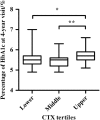The association between the baseline bone resorption marker CTX and incident dysglycemia after 4 years
- PMID: 28698818
- PMCID: PMC5496471
- DOI: 10.1038/boneres.2017.20
The association between the baseline bone resorption marker CTX and incident dysglycemia after 4 years
Abstract
Bone is an endocrine organ involved in modulating glucose homeostasis. The role of the bone formation marker osteocalcin (OCN) in predicting diabetes was reported, but with conflicting results. No study has explored the association between baseline bone resorption activity and incident diabetes or prediabetes during follow-up. Our objective was to examine the relationship between the baseline bone resorption marker crosslinked C-telopeptide of type I collagen (CTX) and glycemic dysregulation after 4 years. This longitudinal study was conducted in a university teaching hospital. A total of 195 normal glucose tolerant (NGT) women at baseline were invited for follow-up. The incidence of diabetes and prediabetes (collectively defined as dysglycemia) was recorded. A total of 128 individuals completed the 4-year study. The overall conversion rate from NGT to dysglycemia was 31.3%. The incidence of dysglycemia was lowest in the middle tertile [16.3% (95% confidence interval (CI), 6.8%-30.7%)] compared with the lower [31.0% (95% CI, 17.2%-46.1%)] and upper [46.5% (95% CI, 31.2%-62.6%)] tertiles of CTX, with a significant difference seen between the middle and upper tertiles (P=0.002 5). After adjusting for multiple confounding variables, the upper tertile of baseline CTX was associated with an increased risk of incident dysglycemia, with an odds ratio of 7.09 (95% CI, 1.73-28.99) when the middle tertile was the reference. Osteoclasts actively regulate glucose homeostasis in a biphasic model that moderately enhanced bone resorption marker CTX at baseline provides protective effects against the deterioration of glucose metabolism, whereas an overactive osteoclastic function contributes to an increased risk of subsequent dysglycemia.
Conflict of interest statement
The authors declare no conflict of interest.
Figures
References
-
- Xu Y, Wang L, He J et al. Prevalence and control of diabetes in Chinese adults. JAMA 2013; 310: 948–959. - PubMed
-
- Mota M, Popa SG, Mota E et al. Prevalence of diabetes mellitus and prediabetes in the adult Romanian population: PREDATORR study. J Diabetes 2016; 8: 336–344. - PubMed
-
- Anjana RM, Shanthi Rani CS, Deepa M et al. Incidence of diabetes and prediabetes and predictors of progression among Asian Indians: 10-year follow-up of the Chennai Urban Rural Epidemiology Study (CURES). Diabetes Care 2015; 38: 1441–1448. - PubMed
LinkOut - more resources
Full Text Sources
Other Literature Sources



